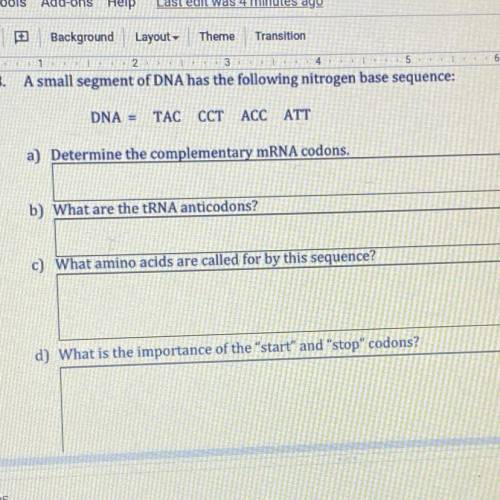6
7.
8
2.3.45
8. A small segment of DNA has the following nitrogen base sequence:...

Biology, 12.11.2020 01:00 desderievelasquez
6
7.
8
2.3.45
8. A small segment of DNA has the following nitrogen base sequence:
DNA =
TAC
CCT ACCATT
a) Determine the complementary mRNA codons.
b) What are the tRNA anticodons?
c) What amino acids are called for by this sequence?
d) What is the importance of the "start" and "stop" codons?


Answers: 1
Another question on Biology

Biology, 21.06.2019 23:00
How do chloroplasts set plants apart from other living things
Answers: 1

Biology, 22.06.2019 00:30
Imagine that certain laws of physics could be ignored and you were able to travel vast distances in moments. now imagine that you traveled to an earth-like planet located light-years away that is known to support life. think about what you’ve learned in this unit and make an argument for what you think would be the dominant type of life form on this planet. consider whether a notochord is required for an organism to manipulate its environment and become a dominant creature.
Answers: 3

Biology, 22.06.2019 00:30
On a recent expedition to a remote region of northern canada, scientists uncovered skeletal remains from about 100,000 years ago. surprisingly, all the skeletal remains, which included many species from differing biological families and spanned about two thousand years, showed evidence of experiencing temperatures in excess of 1000 degrees fahrenheit (or 538 degrees celsius). which of the following, if true, best explains the apparent paradox between the cold environment and the evidence of the bones experiencing hot temperatures? (a) chemical changes that naturally occur during the process of decay in only one north canadian species produce the same evidence of the species' skeletons being exposed to hot temperatures as the expedition scientists found. (b) a little over 103,000 years ago, a large fire is known to have occurred in northern canada. (c) strong evidence exists that as early as 70,000 years ago, homo sapiens around the world relied heavily on fire to cook animals. (d) in the same expedition and in roughly the same layer of excavation, scientists found rudimentary wood cutting and hunting tools used by early humans.
Answers: 3

Biology, 22.06.2019 04:00
The nervous system interacts with the endocrine system by a. using hormones as connections b. sending nerve impulses directly to glands c. using neuroendocrine cells as connections d. sending neurotransmitters directly to neurons
Answers: 1
You know the right answer?
Questions

Physics, 16.11.2019 16:31

Mathematics, 16.11.2019 16:31

Mathematics, 16.11.2019 16:31

Biology, 16.11.2019 16:31


Biology, 16.11.2019 16:31

Mathematics, 16.11.2019 16:31

English, 16.11.2019 16:31

History, 16.11.2019 16:31


Biology, 16.11.2019 16:31

English, 16.11.2019 16:31

SAT, 16.11.2019 16:31

English, 16.11.2019 16:31

English, 16.11.2019 16:31







